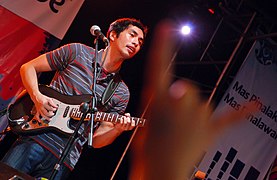Design
Design
Personality
Chart Properties
Your Cross represents the specific theme of your life. This cross embodies your unique potential & the lessons you're here to learn, providing a roadmap to fulfilling your life purpose.
We use the UTC birth time and date to do the calculations required to generate your Human Design chart.
Buy Tokens
Pay as you use, no expiry and no subscription required.Prompt Ideas
Get inspired with some epic prompt ideas.Rachel Corrie's Biography
American activist killed in a demonstration in Palestine when an Israeli military bulldozer struck her on March 16, 2003. She was 23.
At the time of her death she was a senior at Evergreen State College in Olympia, Washington, in Palestine on an independent study program. A gifted writer and crusader from an early age, Corrie concentrated her college studies on community organizing. One of her professors said that she “has a strong sense of social justice. Basically, she wanted to do something about it instead of just talk about it.”
Corrie was a member of the International Solidarity Movement (ISM), a group which opposed the Israeli occupation of the West Bank and the Gaza Strip. On her independent study program, Corrie arrived in Palestine in January 2003. While there she became more and more horrified by the violence and poverty amidst which the Palestinians lived and the trauma suffered especially by the children. For several months prior, the Israeli Army had been trying to create a security zone by bulldozing homes around Rafah, Palestine that they considered safe houses for Palestinian fighters. Corrie and other members of ISM wanted to call attention to the Palestinian plight and help the Palestinians withstand the Israeli forces. In February, Corrie successfully participated in the group’s plan to stop the destruction by becoming “human shields”—that is, using their bodies to block the destruction. She was not so fortunate the following month.
On March 16, 2003, Corrie and seven other members of ISM donned their fluorescent orange outerwear and took their positions in front of the few remaining homes in Rafah. Consistent with the group’s plan, Corrie knelt down in front of the home she was trying to protect and watched the bulldozer approach. When she realized that it was not stopping, she tried to rise but earth and debris kicked up by the huge machine felled her. Just after 5:00 PM local time in Rafah on that eventful day, she was crushed by the bulldozer as it advanced on its mission. Suffering massive injuries, she was rushed to a hospital where she was pronounced dead at 6:30 PM.
Her parents pressed for an investigation into the circumstances of her death and subsequently sued the state of Israel, the Israeli military, and Caterpillar, the manufacturer of the bulldozer. Fellow protestors claimed that the bulldozer deliberately ran over her, more than once. The Israeli Army claimed that the driver did not see the young woman and declared her death “a regrettable accident.” Critics have harsh words for what they call her misplaced sympathies, her anti-American protests and her foolish actions while supporters note what they deem her courage, her sense of honor and justice, her devotion to bringing peace and her ultimate sacrifice.
Rachel grew up in a home that stressed education and independent thinking. Her parents say that they tried to inculcate into their three children a world view that encompassed helping others less fortunate. An aspiring writer and artist, she recorded her keen observations and passionate views in her journals and in prolific correspondence with family and friends. Not long before her death, Rachel had written to her father from Rafah:
This has to stop. I think it is a good idea for us all to drop everything and devote our lives to making this stop. I don’t think it’s an extremist thing to do anymore. I still really want to dance around to Pat Benatar and have boyfriends and make comics for my coworkers. But I also want this to stop.
Her own words as well as others’ remembrances assist in the effort to keep her story alive. In January 2006, a play entitled “Flowers of Red” written by Eliza Wyatt and based on Corrie’s experiences in Gaza as well as the violence there, opened in Boston, MA. British actor Alan Rickman and reporter Katherine Viner also constructed a play drawing directly upon her writings from Rafah. Their play entitled “My Name is Rachel Corrie” had a successful run in London. However, its opening in New York, scheduled for March 22, 2006, was “postponed indefinitely” for fear of controversy and protests. In June 2006 another play by Deborah Peabody, “The Words of Rachel Corrie,” opened in Provincetown, MA. Late the same month came an announcement that “My Name is Rachel Corrie” would indeed open in New York City—at a different theatre from the one originally scheduled and in October 2006.
Link to Wikipedia biography
Link to Astrodienst discussion forum
Your Cross represents the specific theme of your life. This cross embodies your unique potential & the lessons you're here to learn, providing a roadmap to fulfilling your life purpose.
We use the UTC birth time and date to do the calculations required to generate your Human Design chart.
Prompt Ideas
Get inspired with some epic prompt ideas.

Walcyr Carrasco
3/5 Emotional - Solar Plexus ProjectorAndre Lhote
5/1 Sacral GeneratorSimon Kaj Jakubowitz
4/6 Emotional - Solar Plexus ProjectorWalt Kelly
2/4 Emotional - Solar Plexus Manifesting Generator

Harold Ramis
6/2 Emotional - Solar Plexus Generator





